Study Good Will Hunting if you're serious about
-- avoiding the Top 7 Deadly Mistakes of a Bad Screenplay, and
-- getting your screenplay read, not tossed.
We "dissected" this movie script in terms of story, character, conflict, dialogue, format and structure.
Just follow our in-depth analysis and apply our findings to your own screenplay. You'll get the opportunity to acknowledge what works and fix what doesn't.
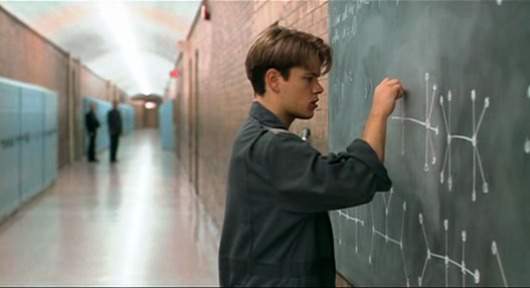
Inside of our series "Learn From The Masters" we chose to review the screenplay Good Will Hunting as its story is very inspirational for all of us screenwriters.
Two young people, Matt Damon and Ben Affleck, completely unknown at the time, wrote a masterpiece and insisted to play in it.
A demonstration of "walking the talk", since the main question of their Oscar winning screenplay was: "What do you want to do with your life?".
We dissected the screenplay to access its "source code", and each of us reviewed it from his area of expertise.
"Dr Read" lays out the story;
"Cool Dude" talks about the characters;
"Dr Read" dismantles the various conflicts;
"Blablator" reviews the dialogue and dialogue techniques;
"Formatman" picks up some interesting elements of screenplay formatting; and
"Structor" reveals the main structure points.
Dr. Read:
Good Will Hunting is the story of Will Hunting, a genius young man, haunted by his past of abused orphan, who sneaks around at MIT to finish math formulas that only one or two people in the world could do. 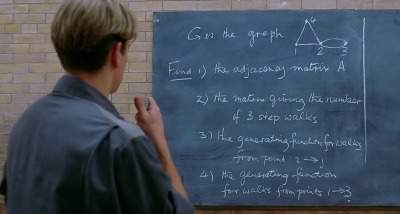
The only people he trusts are 3 friends with whom he spends his time drinking beers, making jokes and fighting. 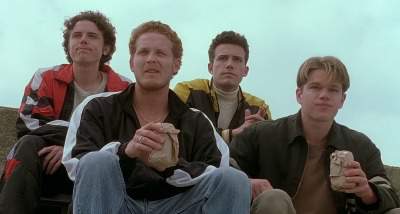
His life gets upside down when he gets arrested for assault, meets his match in the psychologist he's assigned to, Sean Maguire, 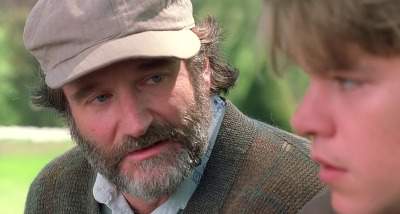 gets attracted to a girl that he's afraid to commit to, Skylar,
gets attracted to a girl that he's afraid to commit to, Skylar, 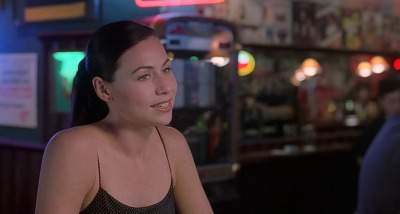 and cannot run away anymore from the question everybody asks him: what do you want to do with your life?.
and cannot run away anymore from the question everybody asks him: what do you want to do with your life?.
Good Will Hunting is a brilliant screenplay as everything (dialogue, characters, structure, story) is in service of having the reader experience emotions.
You get to live with the characters, accompany them in their struggles, laugh with them and be moved when they are.
Good Will Hunting is also a very inspiring story about courage and "doing what's in your heart" like Sean Maguire, the therapist, would say.
It definitely has the "What a script!" factor as this is what you say to yourself when you read the last lines of the screenplay.
No wonder Good Will Hunting's screnplay got so many awards, including an Oscar, a Golden Globe and a Silver Bear at the Berlin festival.
There are some extraordinary elements and scenes and it is definitely worth your time to study them to find out how they got put together.
Let's start with the characters.
Cool Dude:
Good Will Hunting main character is obviously Will Hunting.
This is the way Will is introduced:
"WILL HUNTING, 20, handsome and confident, a softspoken leader."
This description meets the 12 characteristics of a compelling character description that hook the reader.
The name of a character is never an accident, as it is a way to convey some information.
Check our 10 tips to create the "right" name for your character. It is part of 11 steps to create a compelling character.
So what's in Will's name?
There are a few meanings for "Will", including strong-willed warrior and desiring peace.
And "hunting" means the act of conducting a search for something.
So if we apply the name to the story of Good Will Hunting we've got a strong-willed warrior, desiring inner peace, searching for being complete with his past so that he can move forward with his life.
The name fits perfectly with the description "confident, softspoken leader".
And it reveals the character arc.
Will starts as a cocky, arrogant, genius, troubled mind, pushing people away before they have a chance to leave him. He ends as a young man, at peace with his past of abuse, able to trust others and himself, ready to commit to a relationship and move on with his life.
Even the way he talks changes. Will starts by being hostile and sarcastic towards Sean Maguire, the therapist who has been assigned to him. He ends up by acknowledging Sean for the difference he made in his life.
What makes Will also a multi-dimensional character is that he has a brilliant and troubled mind.
One moment he fights in the street with an extreme rage, the next moment he solves difficult mathematical proofs in no time.
One moment he speaks in a very popular manner, the next moment he quotes statements from the prominent Congregationalist clergyman Henry Ward Beecher, when arrested in court.
One moment he shows up as confident, the next moment he's afraid to commit to the relationship with Skylar.
All these contradictions make us be interested in Will. We get to root for Will as we get more and more aware of his inner demons and we want him to overcome them.
This brings us to the notion of conflict, BAM!?
BAM!:
Aaron Sokin said in an interview: " you always look for where is the point of friction - 2 people have to disagree on something for there to be a scene."
This is exactly what happens in Good Will Hunting, and this is what makes this screenplay remarkable. There is a point of friction in nearly every scene. And this friction has different forms - it could be a verbal exchange or a physical fight. It could be subtile or not.
As a result, even in the smallest scenes of Good Will Hunting, there is a conflict going on. Every time, 2 people disagree, BAM!
For example:
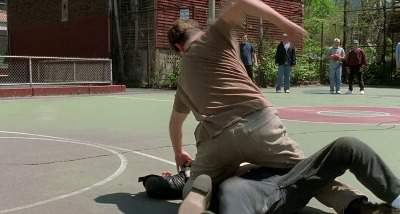
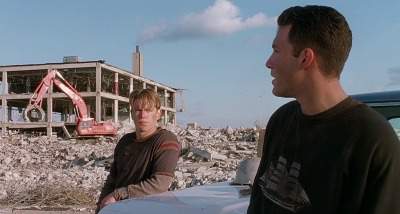
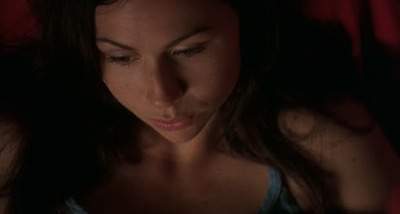
Friction, friction, and again friction. Every time the characters in the scene want someting different. And the conflict escalates.
There are 2 conflict scenes in Good Will Hunting which are my favorites, because of their brilliance and efficiency.
They are like a fight between two fencers, a fight made of attacks, parries, evasions and a final blow.
1. The first meeting between Will and Sean, the therapist allocated to his case.
Will tries to push all Sean's buttons.
These are the last seconds of this exchange. In 7 pictures:
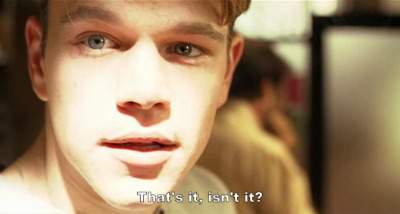
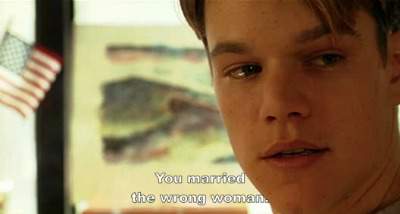
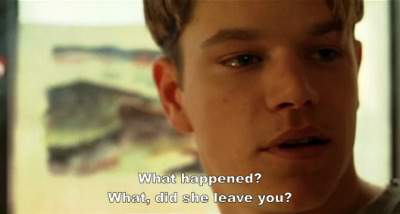
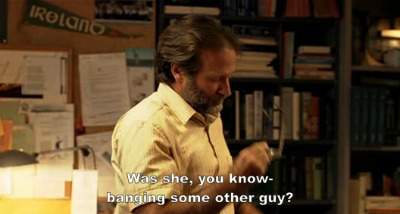
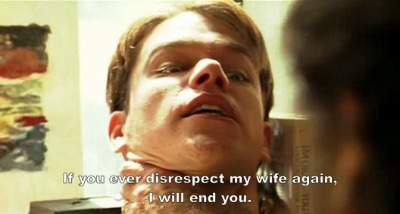
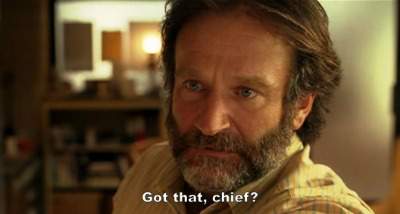
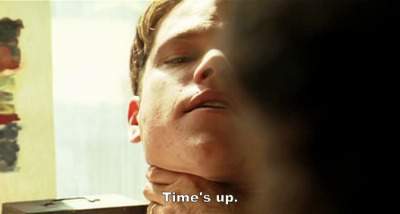
2. The break up scene between Will and Skylar.
That's one of my favorite scenes of Good Will Hunting. Why? because it's like a storm, a perfect and yet completely unpredictable storm.
It starts softly with love and caresses and ends up with complete anger, physical violence and devastation.
And it rings so true. 2 people on rails, pushing each other buttons, and destroying their relationship before they have the chance to realize what they did.
Blablator:
And this scene of Good Will Hunting uses various dialogue techniques, including avoidance, list, repetition, put down, push button, trigger, telling it like it is and setup and payoff to achieve this effect.
BAM!:
If we "dissect" this scene of Good Will Hunting we'll see basically 11 steps in this conflict, and each of them escalates the matter up to the climax, the breakup.
| # | Action |
|---|---|
| 1 | Skylar and Will lay on the bed, Skylar gently caressing Will's back who's still kind of sleeping. Skylar says something that seems very innocent for the reader that we are; yet it triggers the whole incident: "Come with me to California." (she's moving from Boston to California for her studies). Her tone is gentle, loving. Suddenly Will is awake, sits down in bed, asks her if she's sure and how she can be sure it won't be a mistake. He gets upset at the thought that it might not work out and he would be stuck with someone who really doesn't want him there and just wishes they had a "take-back." |
| 2 | Skylar gets hurt by Will's hesitation and makes a remark using the push button dialogue technique: "Look, Will if you're not in love with me, you can say that". Her tone is suddenly breaking, offensive. Will then uses the avoidance dialogue technique and mumbles that he doesn't say that. |
| 3 | Skylar makes then another remark using the push button dialogue technique: "Then what are you afraid of?" followed by Will's reaction (using the trigger dialogue technique): "What do you mean "What am I afraid of?"". Followed by "What are you so scared of?" that Will echoes by "What am I scared of?" (again the trigger technique). |
| 4 | Then Skylar - using a combination of "push button" and telling it like it is dialogue technique: "You live in your safe little world where nobody challenges you and you're scared shitless to do anything else-- " |
| 5 | Many "buttons" of Will have by now been pushed. He's angry: "Don't tell me about my world. You're the one that's afraid." He counter attacks using the put down technique and telling her that she just wants a little fling with the guy from the other side and she'll end up with the upper crust anyway. |
| 6 | This time, Skylar's buttons got pushed. Her answer: F.U. She brings then the issue back to where it all started: "So don't put that shit on me. You're the one that's afraid"." Followed by a response from Will, using the trigger dialogue technique: "What the fuck am I afraid of?!" |
| 7 | Then Skylar uses the repetition and list techniques to make her point and the fear more palpable: "You're afraid of me. You're afraid that I won't love you back. And guess what? I'm afraid too." And she concludes again with the repetition amd push button techniques: "But at least I have the balls to it give it a shot. At least I'm honest with you." |
| 8 | That's the final blow for Will, who responds using the trigger technique: "I'm not honest?" Followed by Skylar: "what about your 12 brothers?". |
| 9 | Will, now furious, responds with the line "You (don't) want to hear" using the repetition and list techniques to hammer his point: "You want to hear that I don't really have any brothers? That I'm a fuckin' orphan? Is that what you want to hear?" Followed by "No, you don't want to hear that." Followed by "You don't want to hear that I got cigarettes put out on me when I was a little kid. That this isn't surgery." And it's again followed by the repetition: "You don't want to hear that. Don't tell me you want to hear that shit!!" This line is great as well as it provides information about Will's back-story without exposing it. In this context, it sounds natural that Will brings his past in the dispute. |
| 10 | Skylar makes an attempt to calm Will down and says something that pushes his buttons even further as he's afraid to open himself in the relationship: "Did you ever think that maybe I could help you?" Will responds again with a combination of repetition and put down techniques: "What, you want to come in here and save me? Is that what you want to do? Do I have a sign that says "save me" on my back?" |
| 11 | Which brings Skylar to the final question using the repetition and setup and payoff techniques, using Will's setup line "you don't want to hear": "You know what I want to hear? I want to hear that you don't love me. If you tell me that, then I'll leave you alone. I won't ask any questions and I won't be in your life." By now the conflict is at its climax. And Will gives the final blow with: "I don't love you.", which corresponds to the 5th turning point of Good Will Hunting screenplay structure where "all is lost". |
This is the whole scene:
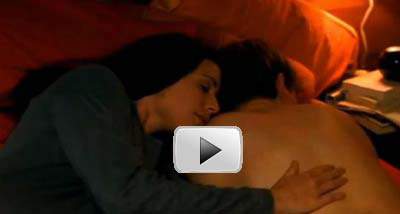
Blablator:
First, the dialogue of Good Will Hunting is sharp and brilliant.
It fulfills every time one or more of the 5 movie dialogue functions. In particular, it causes various emotions by the reader. From laughter to recognition. From empathy to upset. A complete scale of emotions.
Then BAM! gave some examples of how some dialogue techniques got used in the breakup scene. There are three techniques I want to point out because of their extensive and smart use:
We have analyzed this technique and given various examples issued from Good Will Hunting so that you can practice it in your own screenplay.
How Matt Damon and Ben Affleck use this technique is remarkable. It's subtle and is like a game well played.
Don't miss this article on the setup and payoff dialogue technique for all the details. 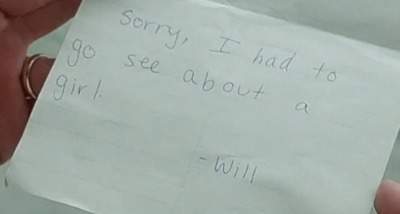
Sean Maguire talks about this dialogue technique in this article titled "It's not your fault". He explains how he uses this technique with examples from Good Will Hunting and the Bourne Identity. 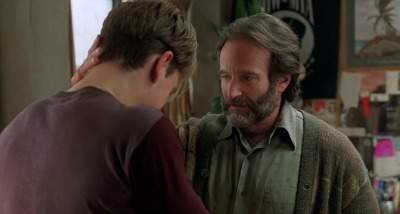
This technique is basically about a harmless / innocent statement told by a character which in the end gets fulfilled.
This is the case when Chucky, Will's best friend, shares with Will that the best moment of his day is when he goes and picks Will up in the morning. And for a short moment, he hopes that Will will not be there anymore. He will have gone without saying a word. Nothing.
And this is exactly what happens in the last scene of Good Will Hunting. Will leaves without notice and Chucky smiles, when he gets that he's best friend is now gone. 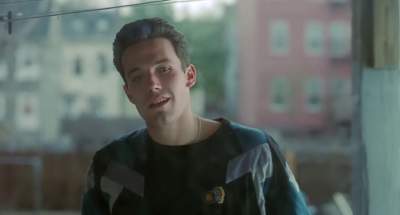
Formatman:
I get regularly questions about screenplay format. Good Will Hunting allows me to answer two of them:
CHUCKIE So Mikey's like "Fuck, I gotta put this thing out of its misery"--So he gets a hammer-- WILL/MORGAN/BILLY OH!
ANGLE ON WILL: SAVAGE, UGLY, VICIOUS, AND VIOLENT2. Amended version with only camera direction:Whatever demons must be raging inside Will, he is taking them out on Bobby Champa. He pummels the helpless, unconscious Champa, fury in his eyes. Chuckie and Billy pull Will away.
ANGLE ON WILL Whatever demons must be raging inside Will, he is taking ...Have you noticed how the first version conveys important information about the character? You're left with the way of being, not the camera direction.
Structor:
Inside of the Michael Hauge screenplay structure model that we have illustrated with some examples (Dead Poets Society and Gladiator) I just want to mention a few Turning points in Good Will Hunting:
* Hancock - screenplay written by Vincent Ngo and Vince Gilligan
| Category | Headline |
|---|---|
| Movie dialogue technique: Repetition | It's not your fault. |
| Movie dialogue technique: Setup and payoff | I had to go see about a girl. |
| Movie dialogue rule #7 | Know your characters intimately |
Pictures and screenplays:
-- "Good Will Hunting" - Matt Damon, Robin Williams, Minnie Driver; Gus van Sant (director), Jean Yves Escoffier (director of Photography) Matt Damon & Ben Affleck (
screenplay)
Go from Good Will Hunting to Whatascript! Home page
* Gladiator, written by David Franzoni, revised by John Logan